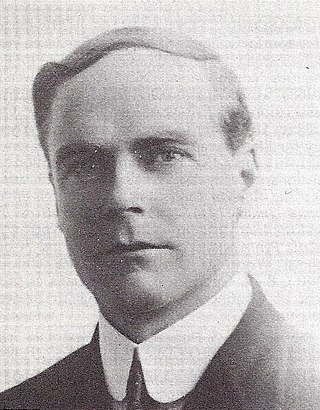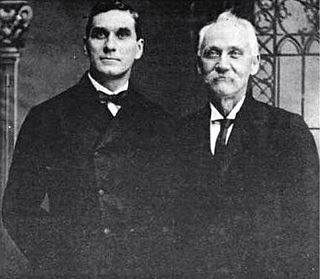Pentecostalism or classical Pentecostalism is a Protestant Charismatic Christian movement that emphasizes direct personal experience of God through baptism with the Holy Spirit. The term Pentecostal is derived from Pentecost, an event that commemorates the descent of the Holy Spirit upon the Apostles and other followers of Jesus Christ while they were in Jerusalem celebrating the Feast of Weeks, as described in the Acts of the Apostles.
The Azusa Street Revival was a historic series of revival meetings that took place in Los Angeles, California. It was led by William J. Seymour, an African-American preacher. The revival began on April 9, 1906, and continued until roughly 1915.

The Assemblies of God (AG), officially the World Assemblies of God Fellowship, is an international Pentecostal denomination.
The Pentecostal World Fellowship is an international fellowship of Evangelical Pentecostal churches and denominations from across the world. The headquarters is in Tulsa, Oklahoma. Its leader is William Wilson.

Open Bible Churches (OBC), formerly known as Open Bible Standard Churches (OBSC), is an association of Pentecostal churches with headquarters in Des Moines, Iowa, United States.

William Joseph Seymour was an African-American holiness preacher who initiated the Azusa Street Revival, an influential event in the rise of the Pentecostal and Charismatic movements. He was the second of eight children born to emancipated slaves and raised Catholic in extreme poverty in Louisiana.
The Latter Rain, also known as the New Order or the New Order of the Latter Rain, was a post–World War II movement within Pentecostal Christianity which remains controversial. The movement saw itself as a continuation of the restorationism of early pentecostalism. The movement began with major revivals between 1948 and 1952, and became established as a large semi-organized movement by 1952 and continued into the 1960s. The movement had a profound impact on subsequent movements as its participants dispersed throughout the broader charismatic and pentecostal movements beginning in the 1960s.

Charles F. Parham was an American preacher and evangelist. Together with William J. Seymour, Parham was one of the two central figures in the development and early spread of American Pentecostalism. It was Parham who associated glossolalia with the baptism in the Holy Spirit, a theological connection crucial to the emergence of Pentecostalism as a distinct movement. Parham was the first preacher to articulate Pentecostalism's distinctive doctrine of evidential tongues, and to expand the movement.

The Pentecostal Assemblies of Canada (PAOC) is a Pentecostal Christian denomination and the largest evangelical church in Canada. It reports 239,267 adherents and 1,076 member congregations throughout Canada. Its headquarters is located in Mississauga, Ontario.
David Johannes du Plessis was a South African-born Pentecostal minister. He is considered one of the main founders of the charismatic movement, in which the Pentecostal experience of baptism with the Holy Spirit spread to non-Pentecostal churches worldwide.
The Australian Christian Churches (ACC), formerly Assemblies of God in Australia, is a network of Pentecostal churches in Australia affiliated with the World Assemblies of God Fellowship, which is the largest Pentecostal denomination in the world.

The Assemblies of God USA (AG), officially the General Council of the Assemblies of God, is a Pentecostal Christian denomination in the United States. The Assemblies of God is the U.S. branch of the World Assemblies of God Fellowship, the world's largest Pentecostal body. With a constituency of over 3 million in 2011, the Assemblies of God was the ninth largest Christian denomination and the second largest Pentecostal denomination in the United States before declining to 2,928,143 in 2022.
The Finished Work is a doctrine associated with Pentecostals of the Finished Work Pentecostal tradition, that locates sanctification at the time of conversion; afterward the converted Christian progressively grows in grace. This is contrary to the Wesleyan doctrine of entire sanctification that locates complete sanctification in a definite second work of grace which Holiness Pentecostals teach is a necessary prerequisite to receive the baptism in the Holy Spirit. The term finished work arises from the aphorism "It's a Finished Work at Calvary", referring to both salvation and sanctification. Though the term is used within Pentecostal Christianity, it is not exclusively a Pentecostal doctrine.

William Howard Durham was an early Pentecostal preacher and theologian, best known for advocating the Finished Work doctrine.

Thomas Hezmalhalch, usually known as Tom Hezmalhalch, was an American missionary, who together with John G. Lake founded the Apostolic Faith Mission of South Africa and was its first chairman and president. He was influenced by the healing ministry of John Alexander Dowie.
Pentecostalism is a renewal movement within Protestant Christianity that places special emphasis on a direct personal relationship with God and experience of God through the baptism with the Holy Spirit. For Christians, this event commemorates the descent of the Holy Spirit upon the followers of Jesus Christ, as described in the second chapter of the Book of Acts. Pentecostalism was established in Kerala, India at the start of the 20th century.

Pentecostalism in Australia is a large and growing Christian movement. Pentecostalism is a renewal movement within Protestant Christianity that places special emphasis on a direct personal experience of God through baptism with the Holy Spirit. It emerged from 19th century precursors between 1870 and 1910, taking denominational form from c. 1927. From the early 1930s, Pentecostal denominations multiplied, and there are now several dozen, the largest of which relate to one another through conferences and organisations such as the Australian Pentecostal Ministers Fellowship. The Australian Christian Churches, formerly known as the Australian Assemblies of God, is the oldest and longest lasting Pentecostal organisation in Australia. The AOG/ACC is also the largest Pentecostal organisation in Australia with over 300,000 members in 2018. Until 2018, Hillsong Church was one of 10 megachurches in Australia associated with the ACC that have at least 2,000 members weekly. According to the church, over 100,000 people attend services each week at the church or one of its 80 affiliated churches located worldwide.
Pentecostalism began spreading in South Africa after William J. Seymour, of the Azusa Street mission, sent missionaries to convert and organize missions. By the 1990s, approximately 10% of the population of South Africa was Pentecostal. The largest denominations were the Apostolic Faith Mission, Assemblies of God, and the Full Gospel Church of God. Another 30% of the population was made up of mostly black Zionist and Apostolic churches, which comprise a majority of South Africa's African Instituted Churches(AICs). In a 2006 survey, 1 in 10 urban South Africans said they were Pentecostal, and 2 in 10 said they were charismatic. In total, renewalists comprised one-fourth of the South African urban population. A third of all protestants surveyed said that they were Pentecostal or charismatic, and one-third of all South African AIC members said they were charismatic.
The doctrines and practices of modern Pentecostalism placed a high priority on international evangelization. The movement spread to Africa soon after the 1906 Azusa Street Revival in Los Angeles.
Sarah Jane Lancaster was the leader of Australia's first Pentecostal congregation. An evangelist and administrator, she established a printing press in her meeting hall to produce evangelistic tracts and pamphlets. Lancaster also published Australia's first Pentecostal magazine, Good News. Lancaster became president of the nation's earliest attempt to organise Pentecostalism into a denomination, the Apostolic Faith Mission of Australasia. Although she is recognised as the founder of Australian Pentecostalism and contributed to the unique prominence of women in the founding of Australian Pentecostal congregations, many of her doctrinal ideas were quickly abandoned as the movement developed.













